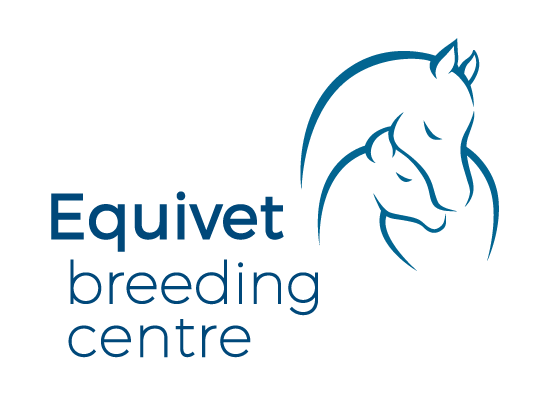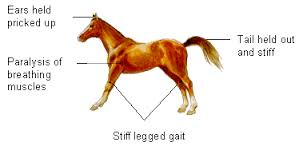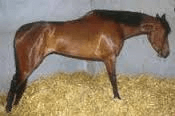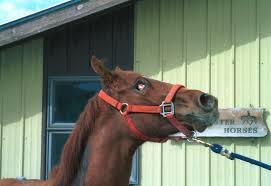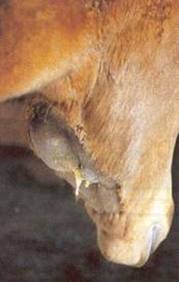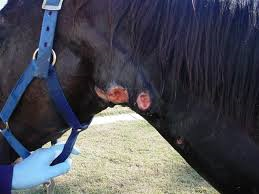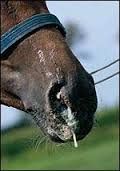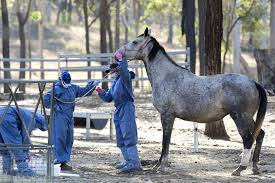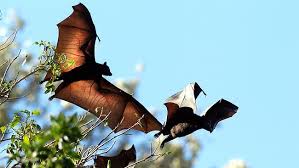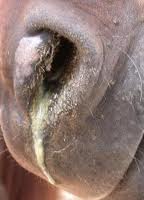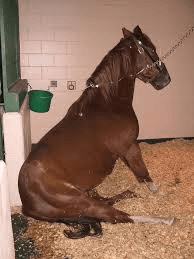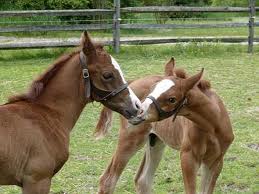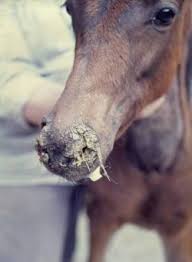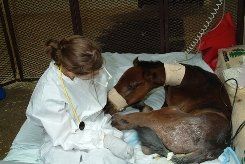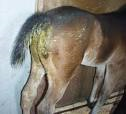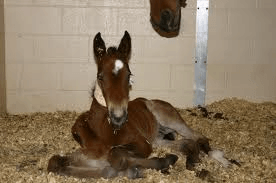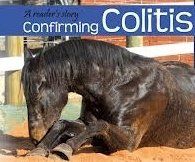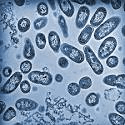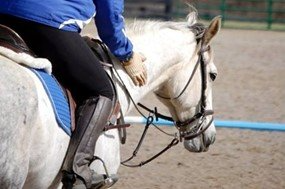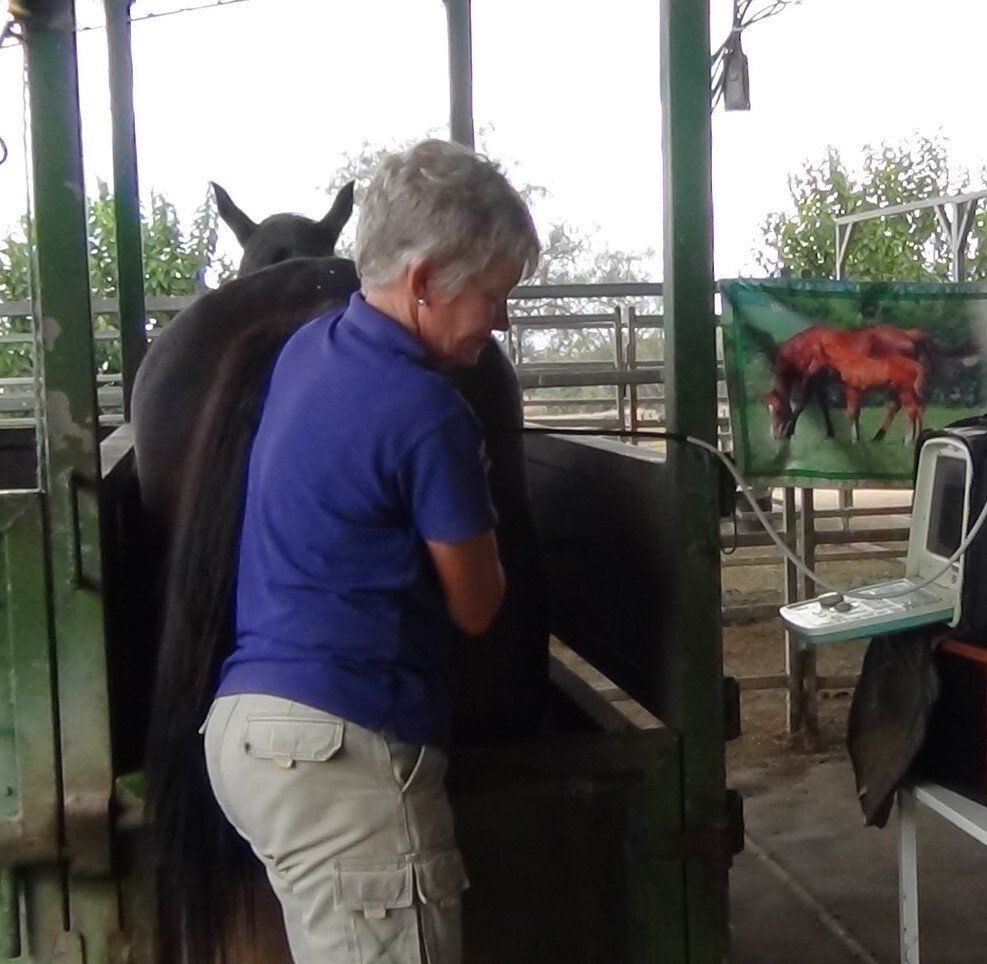Horse talk Articles
Vaccinations are a reliable, effective and simple aid in the prevention and control of several horse diseases including tetanus, strangles, Hendra virus, equine herpes virus, rhodococcus (rattles), rotavirus, and salmonella. The cost and effort of vaccination is very small compared with the probable financial and emotional cost of treatment.
TETANUS
Cause
A bacterium (Clostridium tetani) that is commonly found in the environment, particularly in soil, dust and manure. The bacteria enters animals through a puncture wound in the skin.
Signs
The disease causes increasing stiffness of the muscles due to spasms. As it progresses the horse may not be able to swallow and will have an unsteady gait.
It may stand in a "Saw Horse" pose
(see image right)
The third eye may prolapse
Eventually the horse will be unable to get up, the limbs will become increasingly rigid and finally the horse will be unable to breathe.
Treatment
Antitoxin injections can be administered by your veterinarian, along with medication to control the spasms in the muscles and supportive therapy. Treatment extremely costly and generally unsuccessful.
Vaccination Protocol
The tetanus toxoid vaccine is given into the muscle.
The initial course is two injections 4-6 weeks apart followed by a 12 month booster.
Boosters should be given every 2-3 years or when the horse has an open wound.
Mares should be vaccinated one month before foaling to give the foal immunity.
STRANGLES
Cause
Strangles is a highly infectious disease caused by the bacterium Streptococcus Equi. Strangles commonly occurs in large outbreaks as it is easily spread between horses. Horses carry the organism in their throat and guttural pouches behind the jaw. They can have nasal shedding of the organism for several weeks after clinical signs of the disease have disappeared.
Signs
The horse will develop a fever , show signs of depression, stop eating and have a profuse nasal discharge. Lymph nodes (glands) in the throat become swollen and painful and the horse may have difficulty breathing and swallowing. The swollen areas of the throat may eventually rupture and exude a thick, creamy - yellow pus.
Treatment
Veterinary treatment should begin as soon as clinical signs appear.
Good nursing is essential to make the horse feel more comfortable and help it with eating and drinking.
Vaccination Protocol
The strangle vaccine is given into the muscle. The initial course is three injections given two weeks apart followed by an annual booster. (The vaccine may be administered as a combinated tetanus / strangles injection)
NOTE: This vaccine may not always prevent the disease, but will help to minimise the severity of the symptoms.
HENDRA VIRUS
Cause
Hendra virus is a zoonotic disease which means it can be transferred from animals to humans. It is spread by flying foxes to horses when horses eat or drink the bodily fluids from the flying foxes. It can spread from horse to horse by direct contact with body fluids or by indirect contact with contaminated equipment. The death rate of horses that contract the disease is around 75%.
Signs
There are a broad range of signs and not all may be present in any one horse, but there is generally rapid deterioration with associated respiratory or nervous signs.
General signs include rapid onset of fever, depression, increased heart rate and discomfort / shifting of weight on legs.
Respiratory Signs
Respiratory distress, increased heart rate and a nasal discharge that progresses from white froth to blood stained at or near death.
Nervous Signs
A wobbly gait, apparent loss of vision in one or both eyes, aimless walking / circling in a dazed state, head tilting, muscle twitching, urinary incontinence and eventually the horse is unable to rise.
Treatment
Because the disease is transmissible to humans, at the present time all horses that contract Hendra virus are required by Biosecurity Australia to be euthanised.
Strict personal protection equipment (PPE) MUST be used by persons handling horses suspected of having Hendra virus.
Vaccination Protocol
Vaccination is by injection into the muscle
The initial course is two injections 3 - 6 weeks apart followed by a 6 month booster.
Annual vaccinations are then required.
All vaccinations MUST be administered and recorded by your veterinary surgeon.
EQUINE HERPES VIRUS
Cause
Two distinct viruses - Equine herpesvirus 1 (EHV-1) and Equine herpesvirus 4 (EHV-4).
Signs
Horses develop a fever, depression, loss of appetite and acute respiratory disease with coughing and a nasal discharge. Some strains may also show neurological signs with mild incoordination, loss of bladder and tail control and some skin desensitisation around the vulval area.
Mares may abort several weeks to months after infection. Infection in mares can lead to an “abortion storm” on studs, where most mares in contact mares will abort.
Treatment
There is no specific treatment, but nursing care and antibiotic treatment by your veterinarian will help to minimise secondary bacterial complications.
Vaccination Protocol
The vaccine - Duvaxyn EHV 1,4 – is given by injection into the muscle.
The initial course of two injections 4-6 weeks apart should be commenced at 5 months of age, followed by booster vaccinations every 6 months.
Mares that have had their initial course should be vaccinated at 5, 7 and 9 months of their pregnancy to help control abortions.
RHODOCOCCUS (RATTLES)
Cause
“Rattles” is caused by the bacterium Rhodococcus equi. It lives in the soil and is ingested from the pasture and also spread by nose to nose contact. It is very infectious, particularly in young foals, and can have a high mortality rate.
Signs
Foals develop a high fever, depression, have a thick greenish-white nasal discharge and a cough with a typically ‘rattley sound.
Treatment
Your veterinarian may prescribe a prolonged course of antibiotics and supportive fluid therapy for foals that become severely dehydrated.
Management strategies such as good pasture rotation, minimising dust in yards, removing manure in contaminated paddocks and ensuring that foals have adequate antibody levels will help.
Vaccination Protocol
An effective vaccine is not yet commercially available, but foals can be tested for antibody levels (an immunoglobulin or IGG test) when 24 hours old and plasma administered by your veterinarian if the antibody levels are too low.
ROTAVIRUS
Cause
Rotavirus is a highly infectious disease affecting mainly young foals. It is spread by direct contact with contaminated faeces.
Signs
Severe watery diarrhoea, depression and loss of appetite. Foals can suffer serious dehydration and mal-absorption (inability to obtain nutrients due to severe diarrhoea).
Treatment
Isolation of sick foals is important to limit spread. Supportive veterinary treatment is essential with fluid therapy and extra nutrition either intravenously or by stomach tube.
Vaccination Protocol
A vaccine is available for mares and should be given at the 8th, 9th and 10th months of pregnancy.
SALMONELLA
Cause
A bacterium, Salmonella enterica, causes acute, severe diarrhoea and even death. Can be caused by contaminated feed or water, or by contact with animals actively shedding the bacteria. Stress such as surgery, change of diet, travel or another existing disease appears to play an important role in the development of the disease.
Signs
In a mild case there may be moderate depression, fever, loss of appetite and soft, but not watery, faeces. In more severe cases there will be severe depression, profuse watery diarrhoea and often abdominal pain. They may develop dehydration and severe colic and toxic shock (sometimes called colitis). This form can often be fatal.
Treatment
Veterinary treatment is essential and consists of massive fluid therapy and medications to control the inflammatory bowel response.
Vaccination Protocol
A vaccination is given by injection into the muscle.
Mares - An initial course of two injections 4 weeks apart followed by a booster 6 weeks before foaling.
Foals - An initial course of two injections 4 weeks apart and a 3rd dose 6 months later followed by annual boosters.
The important message is – PREVENTION IS BETTER THAN CURE.
Other Articles

Phone
Postal Address
142 Jimna Springs Road
Cambooya Qld 4358
Location
142 Jimna Springs Road
Southbrook Qld 4363
Follow Us
All Rights Reserved | Equivet Breeding Centre
